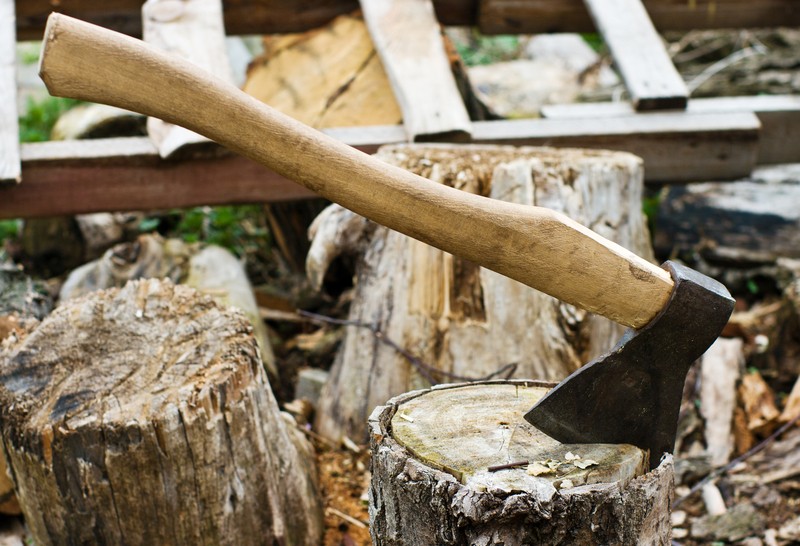Using an ax is a powerful feeling. Sure, it feels great to rev up a chainsaw and bite it into a tree trunk, but the feeling of swinging an ax and watching the wood fly as you pound out a deep chunk into the tree can't be matched. Not only that but axes are much easier to maintain and will last much longer than any chainsaw. To learn how to use this hardcore tool properly, check out the list below.
Preparing for Chopping
Clear your swinging/chopping area. Before you start swinging your ax, you’ll want to prepare your chopping area. You need plenty of room to swing an ax, and you don’t want anything (not even a twig) to get in the way of your swing, as it can cause you to miss your mark, or deflect the ax into your own body. So remember this maxim: “Clear the ground an ax-length’s around.” An “ax-length” means the length of the handle plus the length of your arm. “Around” means overhead and underneath, in front and back, and on both sides. To check that you’ve got this clearance, hold your ax by the head and slowly swing it in all directions. Remove any branches or brush that touch the handle.Falling Trees
Rather than standing directly in front of the tree you’re chopping, you want to offset yourself so that the tree is in front of your lead foot (your left foot if you’re right-handed). Setting yourself up this way will put your target (the tree) “past your front” in the direction of your chopping. This position will allow you to follow through on your swing, but also reduce the chances of injuring yourself if the ax head ricochets off the tree when you strike.
Just like with using a chainsaw, you’ll make an initial 45-degree face cut on the side of the tree that faces the direction you want it to fall. You’re going to make another 45-degree cut with your ax on the opposite side and two inches above your face cut. This will create a hinge and if everything goes to plan, the tree will begin to fall down in the direction of your face cut.Limbing
Limbing is when you remove the branches from a felled tree. Remove the limbs on top of the downed tree first, so that when you remove the bottom limbs, if the tree falls or moves, the top branches won’t flail about and scratch or impale you. Stand on the opposite side of the trunk from where you’re cutting and always chop limbs off in the direction of the top of the tree; do not cut into the “crotch” of the limb.Bucking
Bucking. If you’ve felled a tree, you’ll need to buck it into smaller, more manageable logs. To do this with an ax, stand on top of the log you wish to buck, with your feet a bit wider than shoulder-width apart. You’re going to chop a “V” shaped notch in the part of the log between your legs, chopping halfway into one side, and halfway into the other. You want the kerf, or the cut you’re making, to be as wide as the tree is thick; aim for an angle of cut about 45 degrees.Contact Splitting
For small sticks, it’s actually easier, faster, and safer not to swing at them at all, but rather to split it using the “contact” method. To split a stick down the middle, wedge the ax’s bit into its center, and then bring the wood and ax down together on your chopping block. Twist the wood some if needed and it will usually split apart. To chop a stick in two, set the bit on a slant across its grain. Raise the stick and ax together and bring them down onto the block.How to Handle an Ax Safely When Not in Use
Muzzle the blade. A properly sharpened ax can easily slice through clothing and body tissue, which is why you need to take great care when swinging one. But that circumscription must also carry over to when you’re not using your ax. As outdoorsman Bernard Mason writes in his book Woodsmanship, unsheathed axes have a tendency to “bite.” That is, axes find a way to cut or nick people even when they’re lying inert on the ground — folks can accidentally kick the ax or fall on it.How to Take Care of Your Ax
Keep your ax sheathed and indoors when not using it. Don’t leave your ax outside and exposed to the elements. Moisture will cause the ax head to rust and the wooden handle to warp.
Keep your ax sharp. As old Abe Lincoln said, “Give me six hours to chop down a tree and I will spend the first four sharpening the axe.” A sharp ax is an effective and safe ax.
Never use an ax as a hammer. An ax is not a hammer and shouldn’t be used for driving in nails or stakes.
If you follow these steps, you should have no problem using your ax safely and effectively for whatever purpose you see fit.
Of course, be sure to follow the tips and don't use an ax as a hammer, as this can easily result in your injury (you're essentially swinging the blade end towards your face and neck, which probably won't go well), and can even damage the ax by warping the metal in a way that it isn't designed for.
The other most important lesson is to keep your ax as sharp as possible. A sharp ax is a safe ax because it is much less likely to slip and ricochet.
For more excellent tips like this one and to read the full article, visit Art of Manliness.

All that is common sense
…